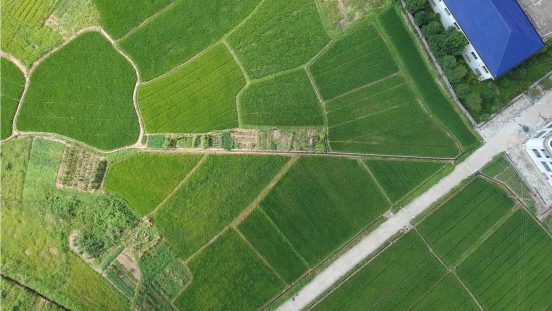What continually fascinates me about rural Hunan is the selection of vegetables – and the amount of chilli – one finds so easily.
Predominantly, coming from small patches between the rice fields.
Rice is the dominant agricultural product of southern China, and especially of Hunan. The many lower-lying grounds, which the surrounding hills and mountains supply with copious amounts of water, are excellent for growing rice. The subtropical climate also does its part.
Some other things like “vineyards” also get more room, because the grapes bring good money.

Much of the vegetable growing, though, is done on small patches. It can be found on soil between buildings and roads. Sometimes it happens on minuscule amounts of soil in interior courtyards of apartment buildings that are otherwise pure concrete.
Sometimes, the vegetable patches are between rice fields, like the one that I had a closer look at.
Dry Ground in Wet Rice
First thing to notice: This vegetable patch was in the midst of the wet rice cultivation, in fields which are flooded – but many of the plants here looked rather dry.
Water spinach was growing there, so it couldn’t have been too dry, at least for plants that root deeply enough. The chilli certainly showed, once again, that it is not the most deep-rooting of plants.
Off and on, in other places and especially for chilli, I have seen farmers separately water the chilli from the irrigation canals for the rice fields. It doesn’t happen too often, though.

Plant Mixing
The way that different species and varieties of plants are organized is quite interesting. Everything has its place, to some extent, but everything is also mixed together somewhat. And sometimes, even more.
Here, for example, there was a definite patch of sweet potatoes at one end. Then came bitter melon, which already seemed mixed with another vine-like plant, perhaps pumpkin.
Some amaranth was growing close to the ground, less recognizable as a vegetable of its own (and not exactly on its own). Then came a definite pumpkin and, probably, some kind of bean, on trellises to climb up.
Aubergine (eggplant) could be found; soy beans, more aubergine and then finally chilli.
More chilli was growing a bit farther away; that one was more obviously of the longer type that is most commonly used in Hunan. A step further, somewhat separate, grew chaotianjiao, the “facing heaven chilli” that is rather more pungent.


The Thing about Chilli Varieties
In the mixture of pod shapes to be found among that chilli, it is quite obvious that these were landraces. At least, the farmer used their own chilli seeds rather than uniform seeds true-to-type, bought from some breeder.
That brings us to the typical problem: There is some diversity, not an obvious variety of chilli. It is just what the farmers grow, what may have been grown for longer already. Or not that long.
Ask someone, what they are growing, and the answer is likely to be the usual: Green chilli or red chilli, long chilli or chaotianjiao. But between different places, these same names will likely mean a type of chilli that is at least somewhat different.
The differences only become relevant, when they become relevant. Either because someone like me goes there and collects some chilli, and has a need to separate those from one place versus another.
Or because the market develops in such a way that farmers no longer sell only on the local market, what they usually sell there (like everybody else), but because there is some interest in the local-authentic of a place. Then it becomes necessary to market things better, to make them differentiated from the others’ products!

Vegetable Diversity on Patch and Plate
It is also always interesting, what one finds grown versus known from dishes – or less known.
Kongxincai, the water spinach, for example, is a very popular vegetable.
Soy beans, when they are grown in such small amounts, are sure to be used as maodou. Fresh, as those “hairy beans”, they are often boiled in their pods. In Hunan, this preparation that is otherwise the same as the Japanese edamame ends up rather heavily aromatized, though.
Or they are shelled, and stir-fried with green chilli and garlic.
But then, there was also okra in this field. Sometime I seem to remember stumbling across its use in China. It was only this summer that I actually ate okra in China for the first time, though – and then promptly found it growing in this vegetable patch, as well.
I had never seen it in China before.
Talking of things (not) seen: The mysterious vegetable I mention at the end of the video is sure to have been malabar spinach.
What always misleads me about it is that the one I grow myself climbs strongly as a vine, while in China, I always see it grown close to the ground.
In food, I have regularly seen it, but only used in one kind of soup that I find to have a rather odd taste…

Leave a Reply
You must be logged in to post a comment.